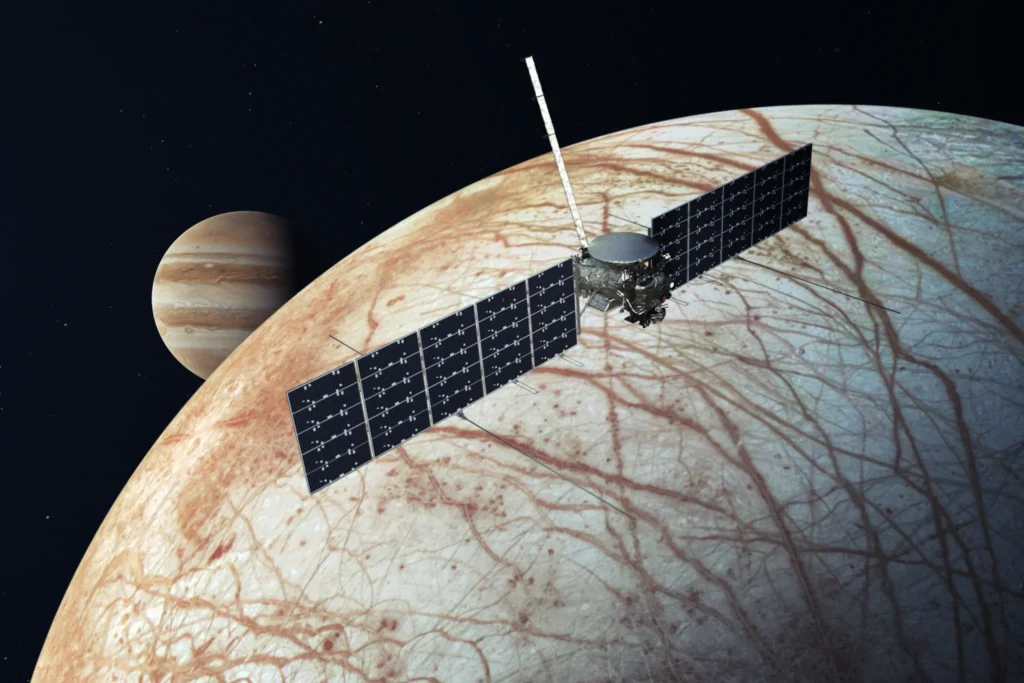
NASA/JPL-Caltech
NASA’s Europa Clipper mission is underway, embarking on an unprecedented exploration of Europa, one of Jupiter’s most intriguing moons. Launched on October 14, 2024, this ambitious spacecraft is now racing through space. On March 1, 2025, Europa Clipper used Mars’ gravitational pull for a slingshot maneuver to propel it toward its destination. A year and a half later, it will perform a similar gravity assist using Earth, then travel another 3.5 years to arrive at Jupiter by April 2030. Its primary goal? To determine whether Europa’s subsurface ocean could harbor life as we know it.

The possibility of extraterrestrial life has captivated humanity for centuries, inspiring groups from conspiracy theorists and filmmakers to scientists. To assess the likelihood of life beyond Earth, researchers have conducted extensive interdisciplinary studies on the origins of life here on Earth. Two prominent theories suggest that hydrothermal vents and tidal pools—both rich in water, heat, and organic compounds—provide ideal conditions for life to emerge.
However, most planets in our solar system lack Earth’s unique suitability. Many don’t spin enough to generate a strong magnetosphere, leaving them vulnerable to solar winds that strip away water. Additionally, being outside the “Goldilocks Zone”—where temperatures are just right—often makes them too hot or too cold to sustain life. Undeterred, scientists have turned their attention to moons, particularly those orbiting Jupiter and Saturn. These gas giants boast numerous moons and immense gravitational fields, which offer two key advantages. First, their size increases the number of orbiting bodies, boosting the odds of finding life. Second, their strong gravitational pull creates intense tidal friction—a force that tugs at the cores of these moons, generating heat and potentially fueling geothermal activity.
Europa, one of Jupiter’s moons, may appear as a barren, ice-covered world at first glance, but it holds tantalizing potential. The powerful tidal forces between Jupiter and Europa could drive geothermal activity, sustaining a hidden ocean beneath its frozen crust—an ocean that might support life. If liquid water is found at Europa, the next step will be to verify the presence of sufficient heat and organic compounds. To investigate, Europa Clipper is equipped with the Mapping Imaging Spectrometer for Europa (MISE). This infrared spectrometer will analyze the spectral signatures of Europa’s surface to characterize Europa’s surface composition. MISE may also offer insights into the circulation between Europa’s ocean and surface, including the water cycle, convection, and more.

Like all scientific breakthroughs, this mission has called on many scientists to collaborate. Surface Optics Corporation had the privilege of performing hemispherical directional reflectance (HDR) measurements on 6-, 8-, 10-, and 12-inch calibration mirrors that were used in Ground Support Equipment (GSE) stages. These measurements, spanning wavelengths from 0.25 to 2.5 microns, ensure the mirrors meet the mission’s rigorous optical standards. In space, optical precision is particularly critical. Optics determine the spacecraft trajectory, the likelihood of overheating, the quality of captured images, and much more.
The Europa Clipper mission is a bold step into the unknown, one that could reshape our understanding of life in our solar system. Though its arrival at Jupiter in 5.5 years may feel distant, the wait promises to be worth it as we anticipate the mission’s stunning images and other data that will deliver groundbreaking insights.
More Information
For more on reflectance, absorptance, and emissivity measurements—or their importance in space exploration—contact our team at contact@surfaceoptics.com.
Read more about the Mapping Imaging Spectrometer for Europa here: https://europa.nasa.gov/spacecraft/instruments/mise/
For more information about Europa Clipper’s journey and mission, see:
https://science.nasa.gov/mission/europa-clipper/
